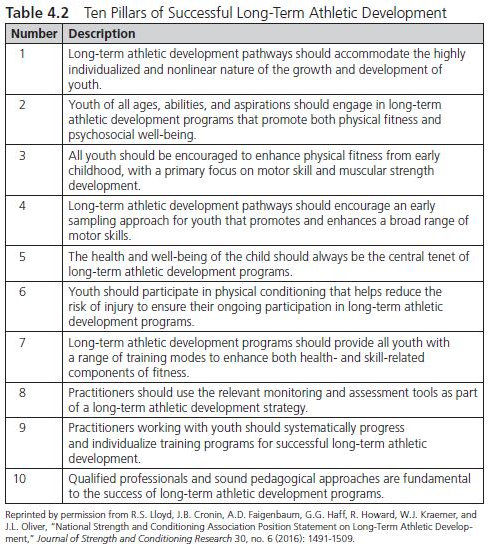Age and Sex Considerations: Practical Application
by Developing Agility
Kinetic Select
December 2023
This article from Developing Agility briefly discusses the importance of age-appropriate speed and agility drills.
The following is an exclusive excerpt from the book Developing Agility and Quickness, Second Edition, published by Human Kinetics. All text and images provided by Human Kinetics.
Most importantly, coaches need to ensure that content is age appropriate. For example, a group of middle school football players should not be performing the same speed and agility training tactics as professional athletes from the National Football League. Effective age-appropriate program design and implementation will contribute to athlete success in both speed and agility development. During the first window of opportunity, special attention should be paid to body awareness and body control with proper movement mechanics. Once motor skills are successfully performed, speed will develop. Therefore, a strong focus on form is crucial during the prepubescent years. Since speed has been shown to decrease during and following PHV, it is recommended that coaches incorporate speed and agility training during earlier prepubescent stages (girls: 6-8 years; boys: 7-9 years). The addition of these skills earlier in youth development may reduce speed disparities associated with the onset of PHV.
Following PHV, the second window of opportunity is characterized by increases in strength due to surges in androgens, specifically testosterone, growth hormone, and insulin-like growth factor. Strength is closely associated with speed, change of direction, and plyometric ability; therefore, the second period is critical for further improvements in speed and agility and drills that address the aforementioned should be included into the training program design.
It is important for coaches to be aware of adolescent awkwardness. Routinely monitoring stature and body weight of athletes in order to identify growth spurts may help practitioners to recognize this phase. During adolescent awkwardness, limb lengths increase but muscles have yet to reach full size or strength (32), which contributes to reductions in motor skill performance. Therefore, coaches may choose to spend more effort reviewing optimal movement patterns for athletes at this time. Spending more time on form and technical skill will allow the athlete to retrain the control needed to attain subsequent high levels of speed and agility. Practitioners will likely need to modify existing motor patterns with reduced loads (18).
Additionally, risk of injury may be heightened during PHV (11). For example, before PHV there is a decrease in bone mineral density, leading to increased risk of bone fractures (11). Further, changes in limb length and mass resulting from growth place disproportionately increased stress on muscle-tendon junctions, bone-tendon junctions, ligaments, and growth cartilage (11). Such imbalances, coupled with the loading demands of sport, may make the affected youth prone to musculoskeletal and overuse injuries (11). Increases in body mass and height of center of mass without corresponding adaptations in strength and power can lead to excessive loading on the musculoskeletal system during dynamic and reactive actions (16, 28). Females, specifically, have an increased risk of knee injury due to their increasing body size without the appropriate increases in hip and knee strength to support their skeleton (28). Females experience a widening of the hips, thus increasing the Q angle of the knee (38). Larger Q angles are associated with increased pressure on the lower extremities (38); therefore, coaches should be sure to select biologically age-appropriate drills and encourage proper recovery.
With youth training, it is recommended that emphasis be placed upon exercise programs that promote physical development, reduce injury, and enhance fitness behaviors across the age spectrum. Long-term athlete development (LTAD) refers to the habitual development of athleticism over time to improve health and fitness, enhance physical performance, and reduce the relative risk of injury (18). A list of the pillars of successful LTAD is provided in table 4.2. This model emphasizes age-appropriate exercises since children’s anatomy and physiology differ from those of adolescents in muscle structure (15, 31), size (12), activation patterns (12), and function (13). Structured training that focuses on age-appropriate drills and movement patterns will provide superior results and reduce the risk of overtraining. Coaches should also educate youth about how their drills will translate into improved performance in their sport. This understanding will help motivate children and build a lifelong future of healthy and enjoyable engagement in sport and physical activity (18).

In Developing Agility and Quickness, leading experts from the National Strength and Conditioning Association (NSCA) offer more than 130 drills, 12 agility and quickness tests, and 15 sport-specific training plans to help athletes gain a step on the competition. The book is available in bookstores everywhere, as well as online at the NSCA Store.
- Privacy Policy
- Your Privacy Choices
- Terms of Use
- Retraction and Correction Policy
- © 2025 National Strength and Conditioning Association